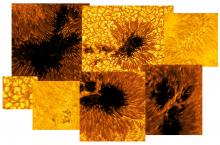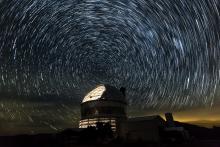Listen to today's episode of StarDate on the web the same day it airs in high-quality streaming audio without any extra ads or announcements. Choose a $8 one-month pass, or listen every day for a year for just $30.
You are here
Sharper View
Few sights are more relaxing than a field of stars twinkling through a dark night sky — at least for most of us. For astronomers, “twinkling” just makes life harder. It blurs the light of distant stars and galaxies. So instead of a sharp pinpoint of light, a telescope sees a star as a fuzzy blob.
Astronomers have developed some techniques to sharpen the view. They use small mirrors that move to compensate for the shifting light coming from a bright star in the telescope’s field of view, for example.
Such techniques have improved the view dramatically. But they have some drawbacks. So a team of astronomers has proposed a new way to sharpen the view: with lasers aboard small satellites.
The team is led by John Mather. He’s a Nobel Prize winner, and chief scientist for the next big space telescope. The team proposes launching one or more small, inexpensive satellites. The satellites would follow orbits that could keep them in view of a single telescope for hours — or even permanently.
A satellite would beam a laser toward the telescope. An improved set of mirrors would bring that beam to a sharp focus. That would sharpen the telescope’s entire field of view. The technique could be especially valuable for a new generation of giant telescopes.
The team says the system could be developed fairly quickly and inexpensively — allowing telescopes on the ground to see the universe as clearly as those in space.
Script by Damond Benningfield





